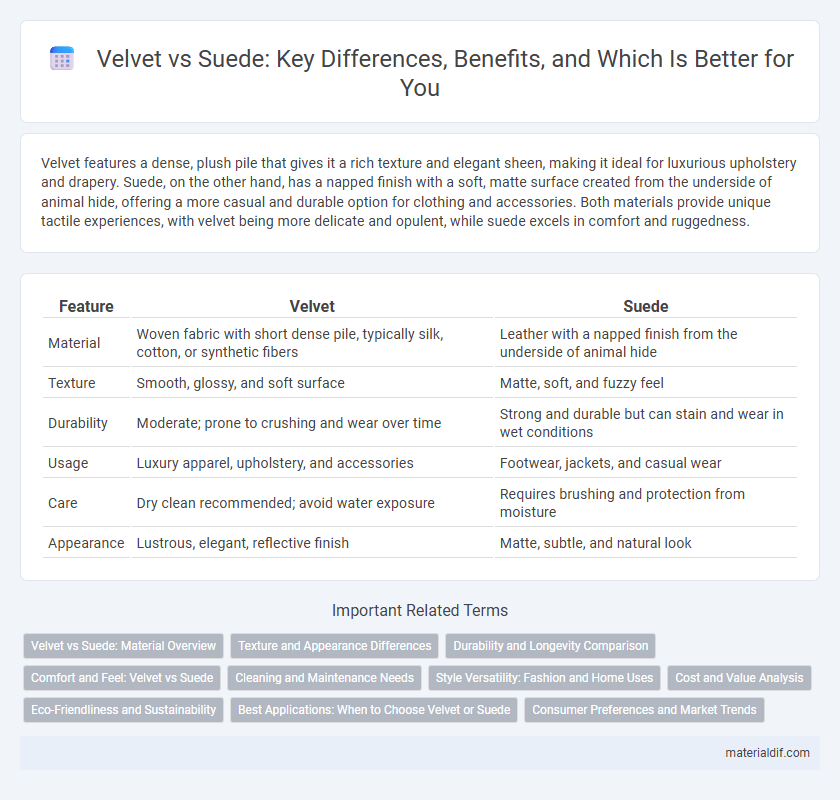Velvet features a dense, plush pile that gives it a rich texture and elegant sheen, making it ideal for luxurious upholstery and drapery. Suede, on the other hand, has a napped finish with a soft, matte surface created from the underside of animal hide, offering a more casual and durable option for clothing and accessories. Both materials provide unique tactile experiences, with velvet being more delicate and opulent, while suede excels in comfort and ruggedness.
Table of Comparison
| Feature | Velvet | Suede |
|---|---|---|
| Material | Woven fabric with short dense pile, typically silk, cotton, or synthetic fibers | Leather with a napped finish from the underside of animal hide |
| Texture | Smooth, glossy, and soft surface | Matte, soft, and fuzzy feel |
| Durability | Moderate; prone to crushing and wear over time | Strong and durable but can stain and wear in wet conditions |
| Usage | Luxury apparel, upholstery, and accessories | Footwear, jackets, and casual wear |
| Care | Dry clean recommended; avoid water exposure | Requires brushing and protection from moisture |
| Appearance | Lustrous, elegant, reflective finish | Matte, subtle, and natural look |
Velvet vs Suede: Material Overview
Velvet is woven from silk, cotton, or synthetic fibers, featuring a dense pile of evenly cut loops that provide a soft, plush surface, while suede is made from the underside of animal hides, resulting in a napped, fuzzy texture. Velvet's luxurious sheen and smooth touch contrast with suede's matte finish and slightly rough feel, designed for durability and flexibility. Both materials serve distinct functions in fashion and upholstery, with velvet often chosen for its elegance and suede favored for a rugged, casual appeal.
Texture and Appearance Differences
Velvet boasts a dense, smooth pile with a luxurious sheen that reflects light, creating a rich, glossy appearance, while suede features a matte finish with a soft, napped texture resulting from the underside of leather. Velvet's texture is plush and smooth to the touch, offering a more elegant and formal look, whereas suede's texture is slightly rougher and more casual, with a subtle nap that absorbs light. These distinct tactile qualities influence their respective uses in fashion and interior design, with velvet favored for opulence and suede for understated sophistication.
Durability and Longevity Comparison
Velvet offers greater durability and resistance to wear compared to suede, making it a preferred choice for high-traffic upholstery and garments. The tightly woven construction of velvet fibers enhances its longevity by maintaining texture and color over time, unlike suede that tends to show scuffs and stains more readily. Suede requires more delicate care due to its porous surface, which can lead to faster degradation and reduced lifespan in comparison to the robust nature of velvet.
Comfort and Feel: Velvet vs Suede
Velvet offers a plush, smooth texture with a soft pile that feels luxurious against the skin, providing exceptional comfort in clothing and upholstery. Suede, derived from the underside of animal hides, delivers a napped, slightly fuzzy surface that is soft but with a more rustic, tactile grip. The dense weave of velvet ensures a cooler, more breathable option, while suede tends to retain warmth, influencing their suitability based on comfort preferences and climate.
Cleaning and Maintenance Needs
Velvet requires delicate cleaning methods such as gentle vacuuming and professional dry cleaning to maintain its soft texture and sheen. Suede, on the other hand, demands frequent brushing with a suede brush and spot cleaning with specialized erasers to prevent stains and maintain its matte finish. Both fabrics are sensitive to moisture, but suede is more prone to water damage, making waterproofing treatments essential for its upkeep.
Style Versatility: Fashion and Home Uses
Velvet offers a luxurious texture with a smooth, glossy finish, making it highly versatile for both fashion and home decor, from elegant evening wear to plush upholstery. Suede, characterized by a soft, matte surface, suits casual fashion items and cozy home accessories, providing a warm, understated aesthetic. Velvet's reflective quality enhances sophisticated styles, while suede's durability supports everyday practicality.
Cost and Value Analysis
Velvet typically commands a higher price than suede due to its complex weaving process and luxurious appearance, offering greater durability and a richer texture. Suede, often made from the underside of animal hide, is generally more affordable but requires careful maintenance to preserve its softness and appearance. When considering long-term value, velvet's resilience and timeless elegance often justify the initial investment compared to suede's susceptibility to stains and wear.
Eco-Friendliness and Sustainability
Velvet and suede differ significantly in eco-friendliness and sustainability, with velvet often crafted from synthetic fibers like polyester, which are less biodegradable and contribute to microplastic pollution. Suede, derived from the underside of animal hides, raises sustainability concerns due to leather production's environmental impact, including high water usage and chemical treatments. However, eco-friendly velvet variants made from organic cotton or recycled materials and plant-based suede alternatives are emerging, offering more sustainable options for conscious consumers.
Best Applications: When to Choose Velvet or Suede
Velvet excels in luxurious upholstery, evening wear, and decorative accents due to its rich texture and elegant sheen, making it ideal for formal settings or statement pieces. Suede offers a softer, matte finish with greater breathability, best suited for casual clothing, footwear, and accessories where comfort and durability are priorities. Choosing velvet or suede depends on the desired aesthetic and functional requirements, with velvet preferred for opulence and suede for relaxed, everyday use.
Consumer Preferences and Market Trends
Velvet and suede both appeal to consumers seeking luxury textures, but velvet dominates in fashion and home decor due to its rich luster and versatility. Market trends indicate a growing preference for velvet in upholstery and apparel, driven by increasing demand for elegant and durable fabrics. While suede remains popular for footwear and accessories, consumer inclination shifts toward velvet's vibrant color retention and easy maintenance, fueling its sales growth globally.
Velvet vs Suede Infographic

 materialdif.com
materialdif.com